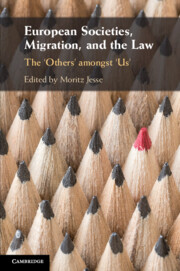Book contents
- European Societies, Migration, and the Law
- European Societies, Migration, and the Law
- Copyright page
- Dedication
- Contents
- Figures and Tables
- Contributors
- Preface
- Acknowledgements
- Abbreviations
- 1 European Societies, Migration, and the Law
- Part I Making the ‘Other’ – The Construction of ‘Otherness’
- 2 The Immigrant As the ‘Other’
- 3 ‘Othering’ in Unconcerned Democracies and the Rise of Anti-liberal Political Divisions
- 4 The Crimmigrant ‘Other’ at Europe’s Intra-Schengen Borders
- 5 The ‘Others’ amongst ‘Them’ – Selection Categories in European Resettlement and Humanitarian Admission Programmes
- Part II The Operation of Legal ‘Othering’ and the National–Foreigner Dichotomy in the EU
- Part III After the Arrival of the ‘Others’ – Reactions to the ‘Refugee Crisis’ of 2015
- Part IV ‘Othering’ in the EU
- Part V European Societies, ‘Otherness’, Migration, and the Law
- Bibliography
- Index
4 - The Crimmigrant ‘Other’ at Europe’s Intra-Schengen Borders
from Part I - Making the ‘Other’ – The Construction of ‘Otherness’
Published online by Cambridge University Press: 13 November 2020
- European Societies, Migration, and the Law
- European Societies, Migration, and the Law
- Copyright page
- Dedication
- Contents
- Figures and Tables
- Contributors
- Preface
- Acknowledgements
- Abbreviations
- 1 European Societies, Migration, and the Law
- Part I Making the ‘Other’ – The Construction of ‘Otherness’
- 2 The Immigrant As the ‘Other’
- 3 ‘Othering’ in Unconcerned Democracies and the Rise of Anti-liberal Political Divisions
- 4 The Crimmigrant ‘Other’ at Europe’s Intra-Schengen Borders
- 5 The ‘Others’ amongst ‘Them’ – Selection Categories in European Resettlement and Humanitarian Admission Programmes
- Part II The Operation of Legal ‘Othering’ and the National–Foreigner Dichotomy in the EU
- Part III After the Arrival of the ‘Others’ – Reactions to the ‘Refugee Crisis’ of 2015
- Part IV ‘Othering’ in the EU
- Part V European Societies, ‘Otherness’, Migration, and the Law
- Bibliography
- Index
Summary
The Schengen Agreement was meant to create a 'borderless Europe'. Yet, from the outset, countries have had a very ambivalent relationship to what Schengen stood for politically – an enhancement of the economy – and what it meant in practice: not being able to properly monitor the movement of flows of people across intra-Schengen borders. Whereas there should be no borders for so-called bonafide, or trusted, travellers, the lack of border control was seen as problematic in keeping out the 'crimmigrant other': the irregular migrant, the criminal migrant, the terrorist migrant. By investing in various modalities of the policing of movement and mobility, one could say that the border is everywhere in an area that was meant to be borderless and that the process of 'othering' is central to its functioning. By bringing together the literature on 'othering' and 'bordering', this chapter considers the utility of borders not just as sites of enquiry in their own right but as ‘epistemological viewpoints’ from which to analyse the processes of differential 'othering' that are at the core of bordering practices in intra-Schengen border zones.
- Type
- Chapter
- Information
- European Societies, Migration, and the LawThe ‘Others' amongst ‘Us', pp. 62 - 80Publisher: Cambridge University PressPrint publication year: 2020
- 2
- Cited by

